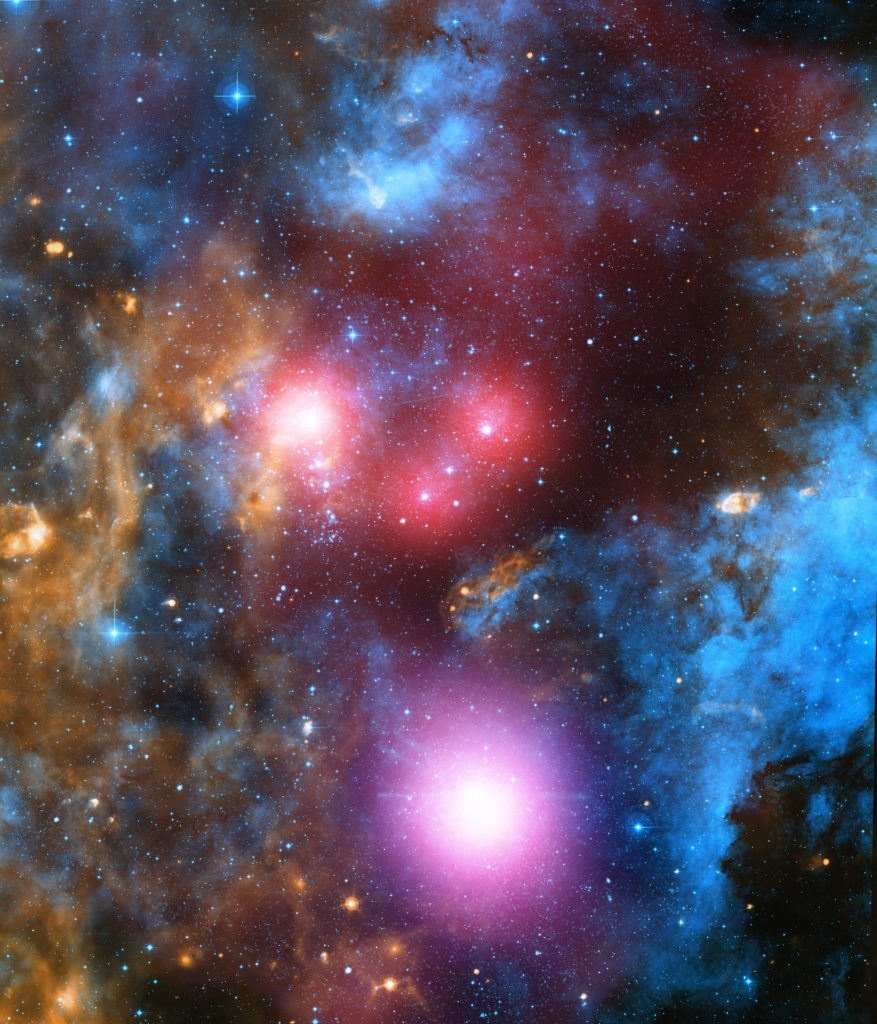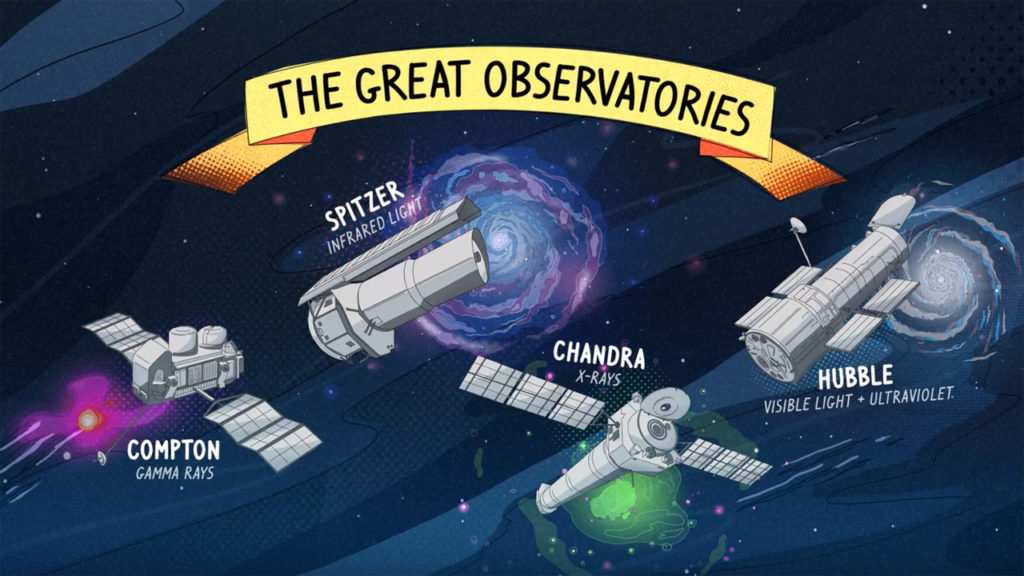This Space.com article “NASA Unveils Amazing Cosmic Views as Chandra X-Ray Observatory Turns 20” (July 28, 2019) reminded me of the limited vision provided only with visible light. Consumer security (and other) cameras have accustomed more of us to regularly seeing infrared light (a longer wavelength part of the electromagnetic spectrum). And that “light” behaves like, well, light regardless. Our experience with X-ray photography, however, is mostly of medical images, again seeing beyond the visible facade of things.
Our progress in understanding the universe has been an adventure in seeing the invisible. The Chandra X-ray Observatory is a key chapter in that saga. Launched in July 1999, this space telescope mission is observing its 20 anniversary. In particular, celebrating the amazing discoveries of multispectral astronomy — “how X-rays complement the data collected in other types of light.” Truly a success of big science (and beyond the ability of Superman, eh).
[NASA] “Chandra remains peerless in its ability to find and study X-ray sources,” Belinda Wilkes, Chandra X-ray Center director, said in a statement. “Since virtually every astronomical source emits X-rays, we need a telescope like Chandra to fully view and understand our universe.”
Chandra’s discoveries have impacted virtually every aspect of astrophysics. For example, Chandra was involved in a direct proof of dark matter’s existence. It has witnessed powerful eruptions from supermassive black holes. Astronomers have also used Chandra to map how the elements essential to life are spread from supernova explosions.
Many of the phenomena Chandra now investigates were not even known when the telescope was being developed and built. For example, astronomers now use Chandra to study the effects of dark energy, test the impact of stellar radiation on exoplanets, and observe the outcomes of gravitational wave events.
Here’s NASA’s YouTube commemorative video:
And here’s a link to a gallery of anniversary images. An example is below.

Notes
[1] More from the YouTube video’s description:
On July 23, 1999, the Space Shuttle Columbia launched into space carrying the heaviest payload ever flown. In its cargo bay was the Chandra X-ray Observatory, a first-of-its-kind telescope that would open a new window into exploring the Universe.
Unlike the Hubble Space Telescope, its older cousin, Chandra detects X-rays from space instead of the kind of light that humans can see. Only a handful of decades before, scientists didn’t know objects in space gave off X-rays. Because the Earth’s atmosphere absorbs this high-energy light, people had to wait until the dawn of the Space Age to realize that space is aglow in light that invisible to our eyes. Once known, a different kind of space race emerged.
The Chandra X-ray Observatory is the culmination of decades of collaboration between scientists and engineers, private and public institutions, the United States and those around the world. Two decades after its launch, Chandra remains the most powerful X-ray telescope and continues to reveal secrets about black holes, exploded stars, and the nature of the Universe itself.


Space.com > “Watch As a Supernova Morphs and Its Speedy Shock Waves Reverse” by Elizabeth Howell (October 14, 2019)
Space.com > “NASA’s Chandra X-ray space telescope reveals a double star system with an alter ego” by Samantha Mathewson (February 24, 2020).
Phys.org > “Astronomers detect biggest explosion in the history of the Universe” by International Centre for Radio Astronomy Research (February 27, 2020).
Data from the Chandra X-Ray Observatory continues to provide insights into our very own Milky Way. In this case, a new way to visualize space near the supermassive black hole Sagittarius A*. This VR tour requires a special headset – only the HTC VIVE is supported.
Space.com > “Visit the Milky Way’s supermassive black hole with ‘Galactic Center VR’ visualization (video)” by Elizabeth Howell (June 4, 2020).
12-9-2021
🚀 New SpaceX launch of NASA’s X-ray Polarimetry Explorer spacecraft – IXPE.
• Wiki
See also:
• Cnet > “SpaceX launches NASA’s new black hole observatory and breaks its own record” by Eric Mack (Dece 9, 2021) – A Falcon 9 rocket sends a new observatory called IXPE into space to study the most mysterious forces in the universe.
Includes YouTube video:
• YouTube > CNET Highlights > “WATCH: NASA’s IXPE Observatory Launch on a SpaceX Falcon 9 Rocket – Livestream” (Dec 8, 2021) – Tune in at 9:30pm PT on Wed. Dec. 8 when NASA’s IXPE Observatory launches into space aboard a Falcon 9 rocket.
References
X-ray optics
Polarization (waves)
🚀 While this APOD contains an excellent photo of the IXPE launch arc, the caption is fascinating as well – about what’s changed for modern humans.
• NASA > APOD > “Launch of the IXPE Observatory” (December 22, 2021)
• NASA > “‘Mini’ Monster Black Hole Could Hold Clues to Giant’s Growth” (Jan 10, 2022)
How do astronomers identify black holes?
• rapid motions of stars in the centers of galaxies
• signatures, such as gas being heated up to millions of degrees and glowing in [high energy] X-rays
Ongoing research topic: How did some black holes grow to a billion solar masses by the time the universe was less than a billion years old?
Data from the Chandra X-ray Observatory used in visualization of binary star system.
• NASA > APOD > “Symbiotic R Aquarii” (February 5, 2022)
Planetary X-rays! Yes, planets can emit X-rays. Holy Ming the Merciless death ray, Batman! (Maybe Superman can see such emissions, eh.) But what’s going on?
Here’s a saga about Jupiter (published February 10 in the journal Nature Astronomy). And moon Io. Ions and auroras. And also electrons and the magnetic field – like a giant particle (electron) accelerator. This article includes a short video.
• Space.com > “NASA space telescope spots most powerful light ever seen on Jupiter, helps solve 30-year-old mystery” by Chelsea Gohd (February 11, 2022)
A story about “more data is always good,” even when you can’t point a space telescope directly at cosmic objects of interest.
• Phys.org > “NASA’s NuSTAR makes illuminating discoveries with ‘nuisance’ light” by Jet Propulsion Laboratory (March 1, 2022)
Here’s another fascinating apsect of some pulsars – antimatter beams.
• Phys.org > “Tiny star unleashes gargantuan beam of matter, anti-matter” by Chandra X-ray Center (March 14, 2022)
Celebrating X-Ray Astronomy: Here’s a well visualized video of the NuSTAR mission after 10 years in space.
• The Caltech Weekly (6-16-2022) > YouTube > Caltech > “NuSTAR Celebrates 10 Years in Space” (June 9, 2022)
Here’s a retrospective on a space telescope with x-ray vision.
• Caltech Magazine > “A Decade of NuSTAR: What Its X-Ray Vision Has Taught Us” (Summer 2022) – Stars are mostly spherical, but NuSTAR observations have shown that when they explode as supernovae, they become an asymmetrical mess.